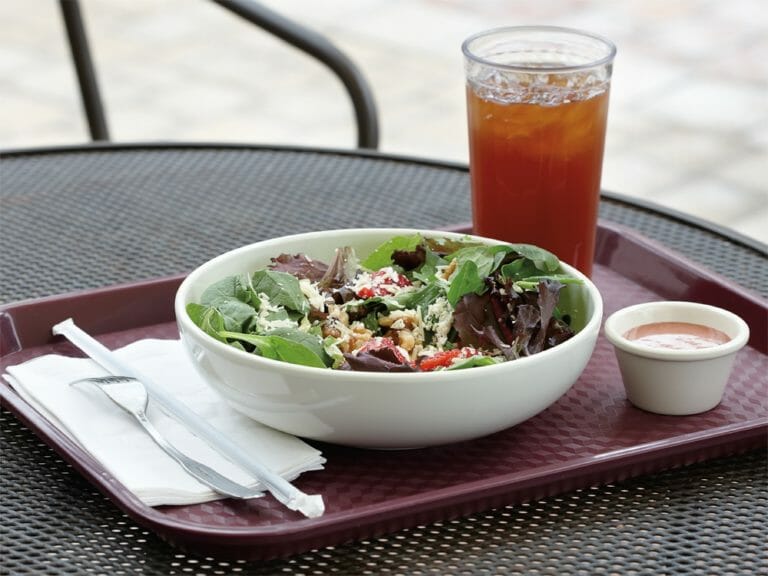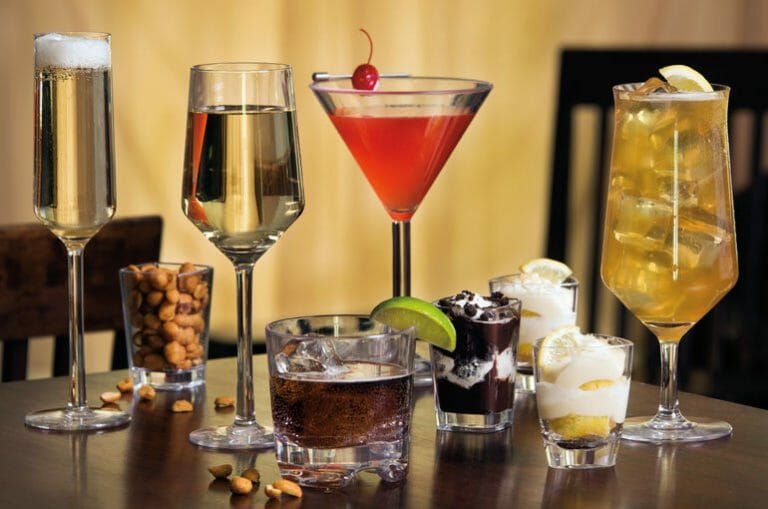4 Easy Steps to Extend Plastic Drinkware’s Service Life
Congratulations! You’ve decided to use plastic drinkware at your foodservice establishment due to the many advantages over glassware. With new designs available in plastic drinkware, your beverage service can look as good as glassware, but won’t shatter like glass if it’s dropped, increasing guest and employee safety. Plastic drinking glasses also tend to have a longer service life because they’re more durable than glass, but it’s important to note that they can break if the circumstances are right.
To get the most out of your investment, you’ll need to practice proper handling, care, and maintenance.
We’re going to walk you through 4 easy care and maintenance steps designed to help you extend the service life of your plastic drinkware. By the end of this article, you’ll be an expert at keeping your plastic glasses looking beautiful for as long as possible, saving your operation money and upholding brand standards. Let’s take a look, shall we?
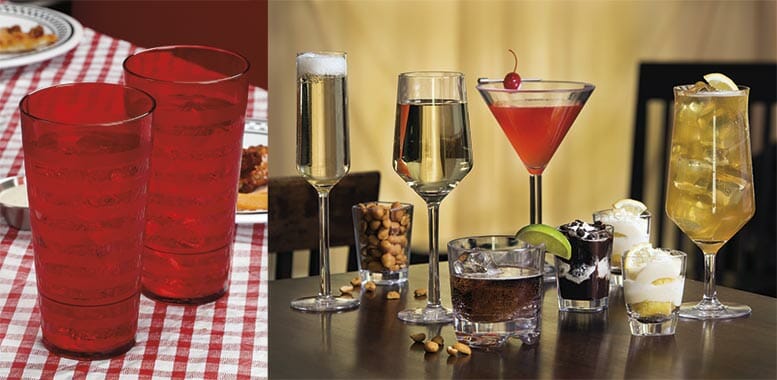 Pictured: SAN Plastic Orbisª Tumblers and Reusable Plastic Stemware & Barware
Pictured: SAN Plastic Orbisª Tumblers and Reusable Plastic Stemware & Barware
Easy Care & Maintenance Best Practices
Caring for your plastic drinkware boils down to 4 easy steps:
- Rinse
- Scrub
- Wash
- Dry
It’s simple enough, but what happens if you skip a step?
Each part of the care and maintenance cycle is crafted to serve a specific purpose for getting the best service life from plastic drinkware. We’re going to take a closer look at the why behind each step.
Rinse
Rinsing immediately after use is recommended because it’s the best way to remove leftover residue from service. Grease or crumbs can be transferred from guests’ hands to their beverage glasses, and other food residue can come into contact with plastic glasses during the normal course of service, especially during the busing process.
If left unattended, residue can lead to cloudiness in your drinkware. Hard water and/or protein buildup can also cause cloudiness. Glassware is similarly affected, so ensuring all of your drinkware is rinsed soon after use broadly benefits your beverage service pieces.
If your drinkware is cloudy, not only does it loose visual appeal, it can also create risk because it’s more difficult to confirm what’s inside. You wouldn’t want to serve cola to a guest instead of the iced tea they were expecting just because you can’t tell the difference due to cloudy drinkware.
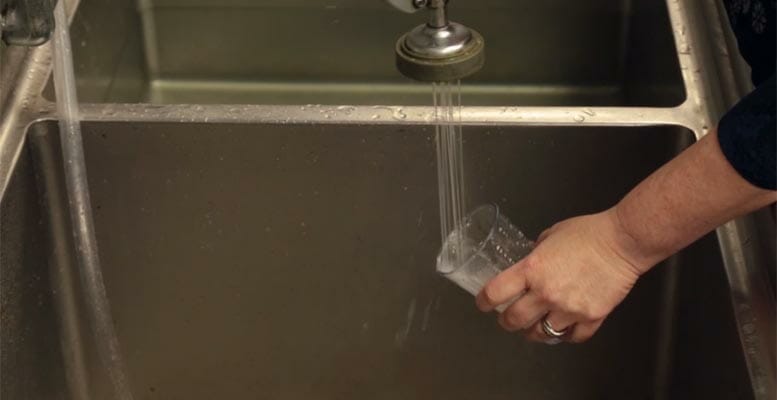
Take rinsing one step further to get even more service life out of your plastic drinkware: Work in bi-weekly pre-soaking to your normal side-work duties.
Put your plastic cups in a tub with warm water and bleach-free granulated dish detergent, and let it sit for at least 4 hours. Pre-soaking puts you ahead of the game and will make daily rinsing that much more effective against cloudiness.
Some operators may say that their typical shift schedule doesn’t allow for 4 hours of pre-soaking time. Not to worry. If you’re tight on time and/or labor, just pick two dates a month to do an overnight soak. The 4-hour mark is the minimum amount of time you want to pre-soak â longer is fine, too.
Pro Tip: Rinsing immediately after use, coupled with at least twice-monthly pre-soaking will do a great deal to protect your drinkware from becoming cloudy.
{{cta(’10c7769d-fa0c-4281-a4f2-90cdd96039b8′)}}
Scrub
After your plastic glasses are rinsed, you’ll want to use a soft sponge or cloth to scrub away any leftover food, grease, or other residue. This step further supports your rinsing efforts because it’ll catch any spots missed during that step.
Using soft materials for scrubbing is important. Plastic drinkware, as durable as it is, is susceptible to scratching. Steer clear of green scour pads and steel wool, and you’ll be in good shape. Both of those materials will scratch your drinkware in no time.
Speaking of scratching, you want to generally avoid busing plastic drinkware in the same bus tub as other tableware. Plates, forks, knives, etc., can scratch your plastic drinking glasses just like green scour pads and steel wool.
Pro Tip: Follow up rinsing with scrubbing to remove remaining residue. Take care not to let abrasive materials like scour pads, steel wool, plates, forks, knives, etc., come into contact with your plastic drinkware.
Wash
Most plastic drinkware used in foodservice is commercial dishwasher-safe. However, different kinds of plastic respond to the temperature of commercial dishwashers in different ways. SAN (styrene-acryolonitrile) will generally hold up 10x longer than PC (polycarbonate), which tends to craze – get hairline fractures – after only 100 uses. Generally, you’ll want to:
- Use a high-heat commercial dishwasher
- They sanitize with temperature as opposed to harsh chemicals like bleach, which aren’t compatible with plastic drinkware
- Be sure to have your temperatures monitored by a technician twice a year to ensure they’re holding as originally set. Temperatures that are too high or too low may result in cleaning issues with your drinkware.
- Use proper compartmentalized dish racks designed to hold drinking glasses
- Don’t stack or overload racks
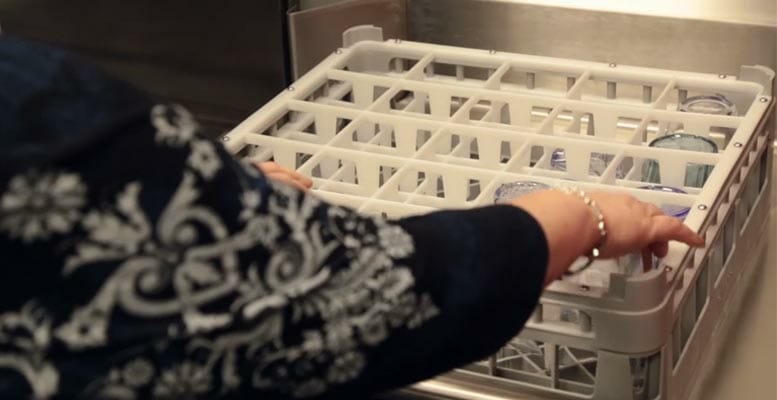
Using compartmentalized dish racks designed specifically for drinkware, and not stacking/overloading reduces the occurrence of scratching, keeping your drinking glasses looking newer, longer.
Bleach and bleach-based products should never be used on plastic drinking glasses because it weakens the chemical bonds within the plastic itself, which can lead to crazing â hairline fractures â in your plastic drinkware. Crazing makes plastic drinkware look old and tired, and can eventually lead to leaking or cracking. If some of your glasses craze, you don’t have to take them out of service right away, but you should be aware of the potential for leaking and cracking.
Pro Tip: Use a high-heat commercial dishwasher in a bleach-free environment to wash plastic drinkware. Be sure to use proper dish racks and avoid stacking/overloading. Both of these steps will reduce scratching and crazing, extending the service life of plastic drinkware.
{{cta(’10c7769d-fa0c-4281-a4f2-90cdd96039b8′)}}
Dry
Drying may be the most tempting step to skip. You’ve already rinsed, scrubbed, and washed your drinkware. Can’t you just get on with your service now? The short answer is yes, but not if you want to get the best service life out of your plastic glasses.
As mundane as it may seem, proper drying protects your plastic drinking glasses from scratching, chipping, and crazing â a trifecta of possible damage.
Crazing doesn’t just happen when bleach is used on plastic glasses. It can happen when your drinking glasses experience thermal shock due to inadequate inventory. A benchmark for how much drinkware you should keep on hand is a ratio of 3:1, or three plastic drink cups for each person you serve, which allows for:
- One plastic drink glass to be in use
- One in wash
- One in rest
What do thermal shock and inventory levels have to do with the drying process? Thermal shock happens when plastic is rapidly heated and cooled over and over again, which stresses the material. If inventory has dwindled below a 3:1 ratio, it’ll get washed more often. Putting ice and a cold beverage into a recently washed, hot piece of plastic drinkware results in a rapid change in temperature.
Essentially, if you have enough plastic drink glasses on-hand, you’ll be able to let them dry completely, which allows for the plastic to gradually heat and cool over time.
Another reason you want to let your plastic drinking glasses completely dry is because stacking them for service while they’re still wet leads to sticking, which in turn leads to scratching. When you do stack your plastic drinkware, be sure to do it fairly gently because over time they’ll chip, crack, or scratch from rough handling.
Pro Tip: Allowing time for plastic drinkware to completely dry greatly helps to reduce chipping, scratching, and crazing. Maintaining adequate inventory levels helps to complete the care and maintenance cycle.
{{cta(‘8d97949d-5da3-4d20-be7d-c81134328a61’)}}
Developing a Care & Maintenance Plan for Your Foodservice Operation
Here’s a quick checklist you can refer to when developing a care and maintenance plan for your plastic drinkware investment:
Do
- Rinse right away
- Pre-soak for at lest 4 hours twice a month
- Scrub with soft sponge or cloth
- Wash in high-heat commercial dishwasher
- Place in proper compartmentalized dish rack for drinks, and always use bleach-free detergent
- Dry thoroughly
- Maintain adequate inventory to reduce how often plastic drinkware is exposed to major changes in temperature
- Generally handle with care
- Stack gently and keep away from plates and silverware to avoid scratching and chipping
Don’t
- Expose to high heat
- Can warp or melt because most plastic drinking glasses aren’t designed for hot applications
- Avoid dropping, throwing, and striking against sinks, trashcans, or other hard surfaces
- Overtime, this will lead to scratching, chipping, and cracking
- Keep in mind that a small chip on the lip of a plastic glass is enough to take it out of service
- As durable as plastic may be, it’s not unbreakable, which is why you want to avoid dropping it. If a plastic glass is hit at just the right angle or dropped on a hard surface, the opportunity for breakage will absolutely increase.
- Use bleach or bleach-based products
- Use scour pads or steel wool
By following these 4 simple steps in addition to generally handling your plastic drinkware with care, you’ll be able to get the most out of your investment, and your guests will enjoy great looking plastic drinking glasses. If you’re interested in more information about the performance of plastic glasses made with SAN and PC, which we mentioned earlier, we’ve got you covered in âPC vs SAN Plastic Tumblers: What’s the Difference?â


